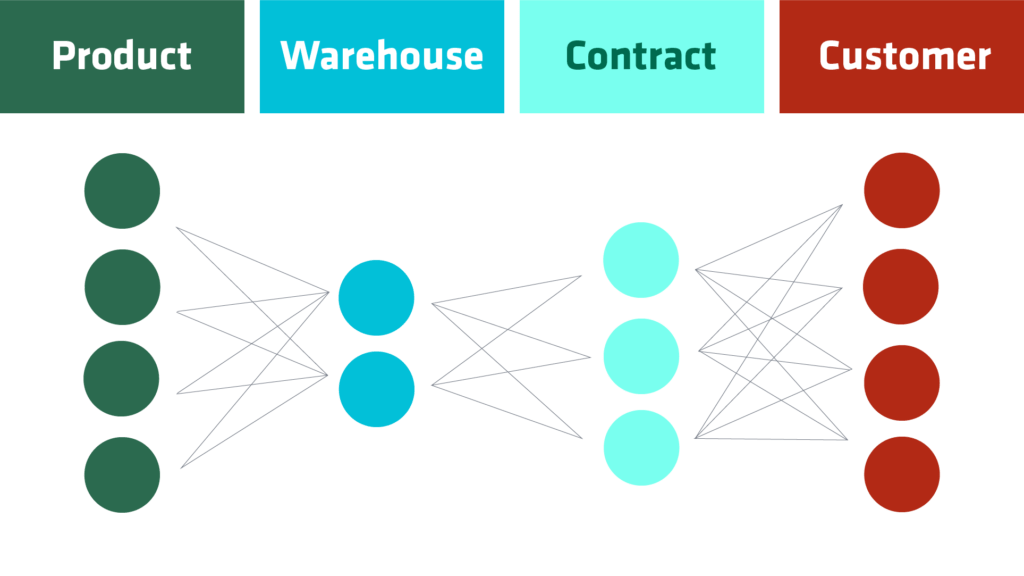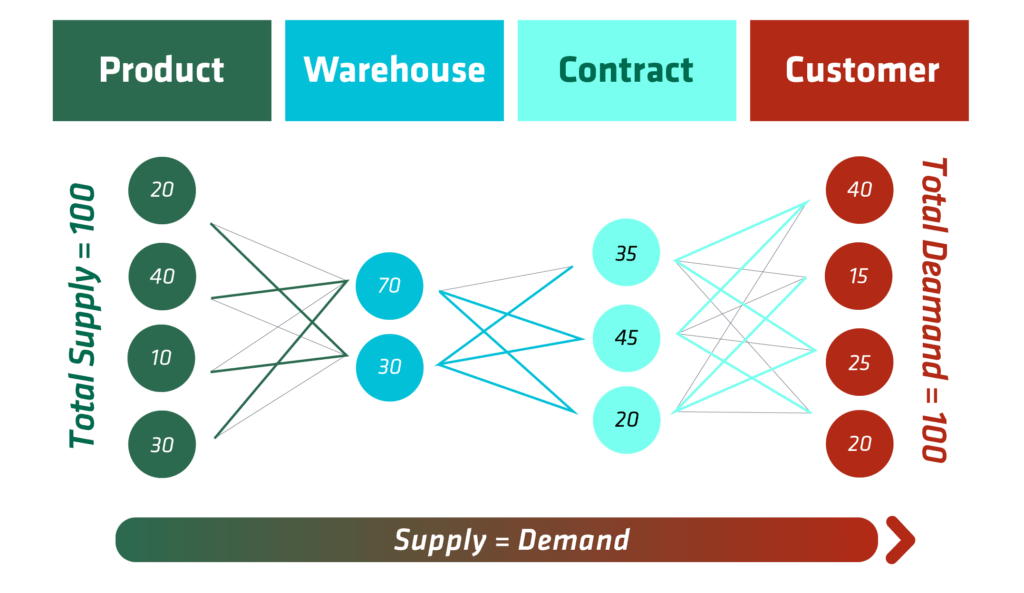Nowadays, every industry is focused on getting more competitive, offering better services to their clients without increasing their costs. Network Optimisation is a popular approach used by companies to improve the effectiveness of decisions and generate more value using a powerful quantitative method that evaluates the supply chain from end to end and provides a crucial understanding of the outcomes. It is a very flexible method that can be implemented in almost every industry, from IT to Finance and Retail. Network Optimisation is a mathematical technique that can be applied to business challenges, solving complex logistics problems and supporting business decisions. With the implementation of a high-performance algorithm, a problem that would take a long time (if not more than a lifetime) for a human being to get to the best solution can now be quickly solved at an affordable time, maximising the value generation.
Problems that can be solved using Network Optimisation
Network Optimisation is widely used across different industries sectors, such as Mining, Energy, Construction, Retail and Manufacturing. The technique can be applied to various business decisions from Strategical to Operational levels to support:
- Strategic Decisions: testing and validating investment scenarios.
- Supply Chain Planning: helping to decide the best way to flow material, maximising value and identifying bottlenecks.
- Logistics Decisions: making the right choice on which route to choose with the lowest cost or shortest path.
Bringing it to practice
Business decisions involving supply chain performance are usually supported by a number of different scenario analyses given all the logistics parameters and constraints (e.g. storage costs, customer location, product strategies, contracts in place, and the possibility of transhipment). It is not an easy task to define the best way to move the materials produced across its supply chain from the production to the customer, and even a simple supply chain can have a vast amount of possible combinations.
Model overview
A practical case shown in the diagram below, with only three products being shipped by two warehouses, through three different available contracts (different logistics costs and capacity) to just five customers, gives us a total of 120 possible combinations, each of them with a different cost and potentially different revenue.
In a more realistic case in which a company wants to create a plan for the next month at a daily level, the number of options to be considered would grow to 3,600.


What a Network Optimisation model in place enables?
A Network Optimisation Model would be able to find the optimal solution to the problem stated above in a few seconds, saving the planning team a lot of time to spend on tasks that deliver value. It would enable the company to make more accurate decisions, faster and in a consistent way, and also analyse the outcome to identify opportunities at different business layers. Very often, companies find out that the logistics contracts in place are undersized and they are using a more expensive alternative or are oversized, and they were paying for unused capacity.
- Marketing level – testing new strategies as new products and new prices and measuring the impact of its decisions on the bottom line.
- Strategic level – it can help the choice of closing one of the warehouses or validating the need to open a new one to maximise investment.
- Operational level – it allows faster recovery to plan when the initial plan goes wrong, guaranteeing the consistency of the solution.
How to implement
Every problem is unique, and so the solution must be customised to meet the requirements of the specific supply chain. However, there are software programs in the market (e.g. CPLEX, Gurobi, AIMMS, etc.) with solvers embedded, which eliminates the need of having to code the entire solution from scratch. These software programs usually use existing algorithms (e.g. Simplex, Branch and Bound, Cutting-plane method) for finding the optimal solution to a problem, and the input is a Linear Program (.lp) which can be developed in many different programming languages (e.g. Python, R, VBA, C++, etc.), according to the skills available on the team.
Results


With the implementation of a Network Optimisation Model, it is guaranteed that the best existing solution is found. However, in the case of a high complexity scenario, and depending on the type of result expected, solving a model might be a very demanding task even for powerful computers. In these cases, the solution would require the implementation of multiple techniques to achieve the desired outcome within a reasonable timeframe. Some of these techniques could mean that a problem that takes years to be solved by a human, and hours for a computer to find the best solution, could take just a few seconds for that same machine for a solution that meets the requirements and is already considered very good by the end user.
Another challenge of the solution is its implementation. It is very common to oversimplify the models and get a final solution that cannot be implemented due to real-life constraints that were not initially considered in the model.
Conclusion
Keeping in mind all the benefits mentioned above, the implementation of network optimisation solutions has proved to be a high-return investment alternative for reducing operational costs, taking the process of decision-making to another level in which all the actions are made based on a quantitative approach, enabling industries to leverage from technology to impact their bottom line.
About the authors
Carlos Cattoi is a Management Consultant at Visagio, specialising in Digital, Analytics, Supply Chain, Logistics and Process Improvement. Carlos holds a degree in Civil Engineering and has experience in the Mining, Rail and Retail sectors across Asia/Pacific and Latin America.


